
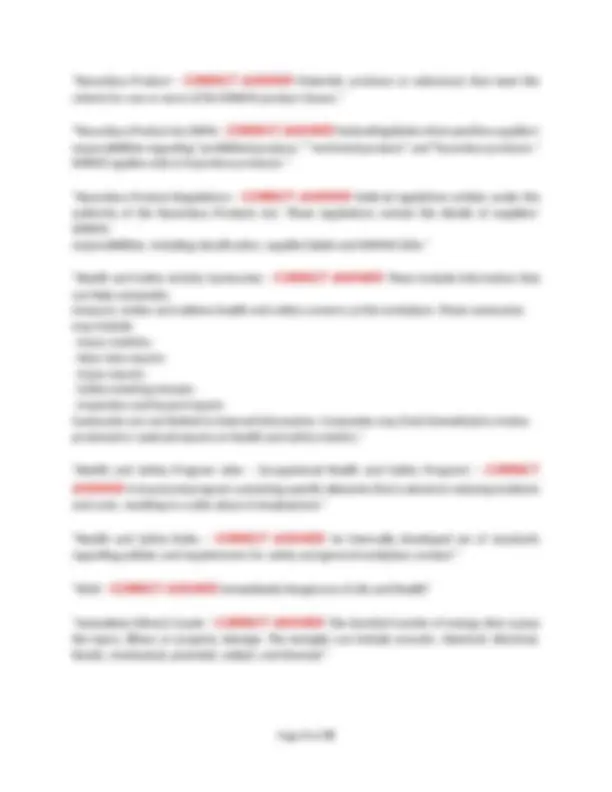
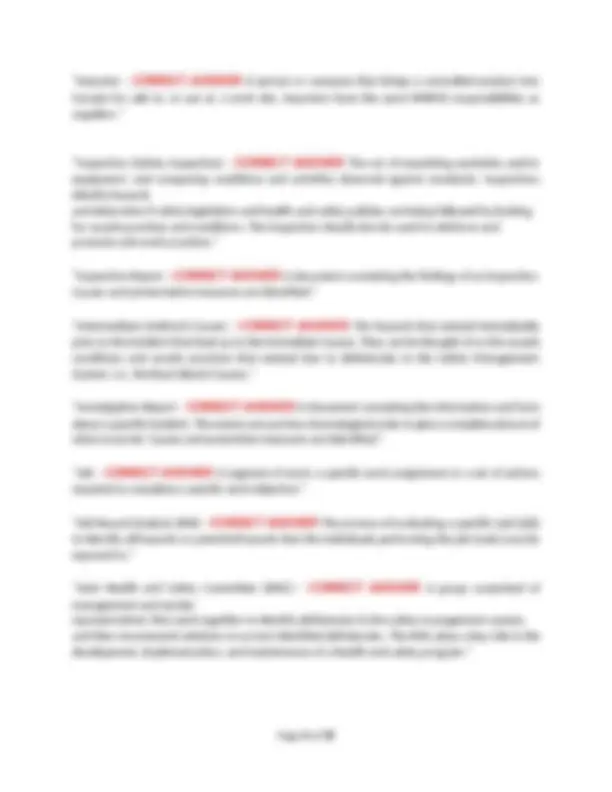
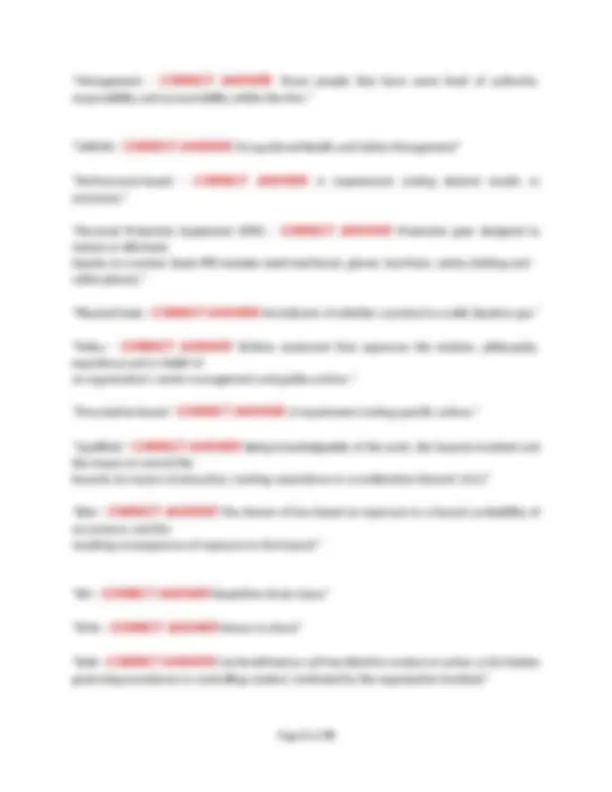
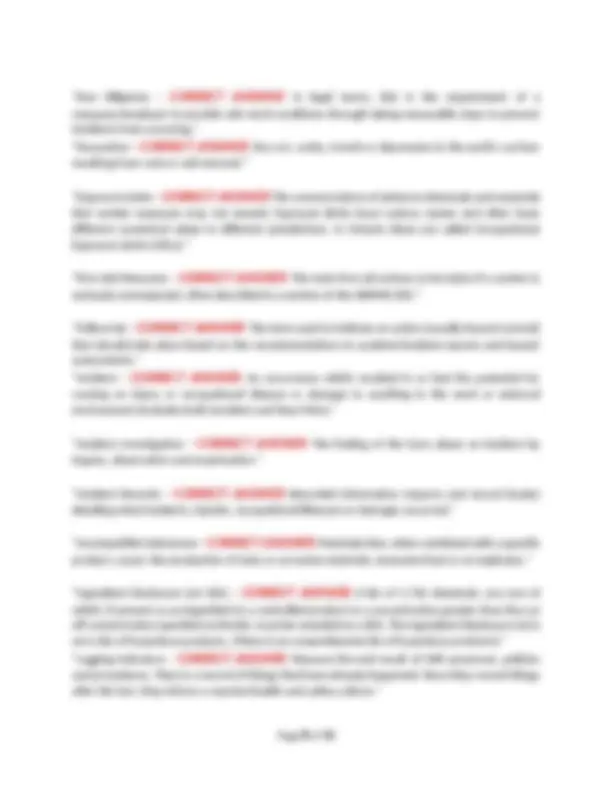
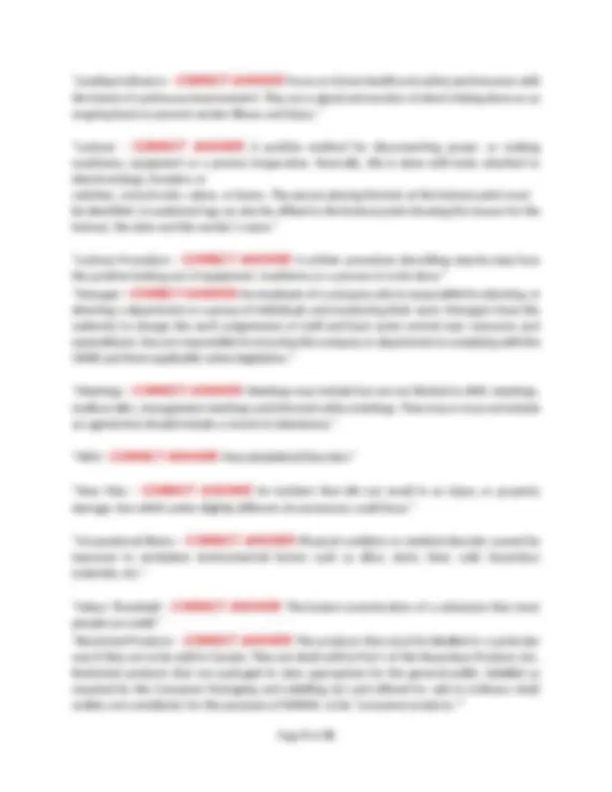
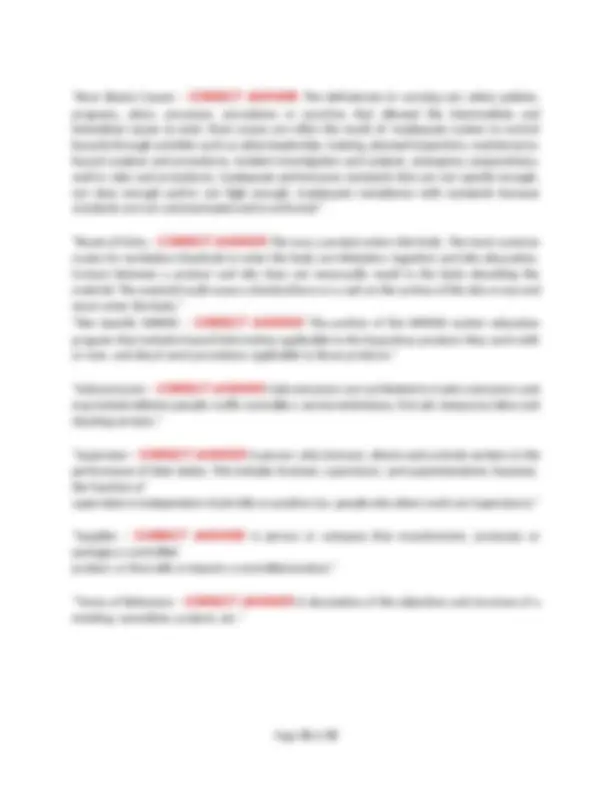


Study with the several resources on Docsity

Earn points by helping other students or get them with a premium plan


Prepare for your exams
Study with the several resources on Docsity

Earn points to download
Earn points by helping other students or get them with a premium plan
Community
Ask the community for help and clear up your study doubts
Discover the best universities in your country according to Docsity users
Free resources
Download our free guides on studying techniques, anxiety management strategies, and thesis advice from Docsity tutors
A comprehensive glossary of terms related to health and safety in the workplace. It defines key concepts such as hazard assessment, risk management, and safety management systems, offering valuable insights for students and professionals in occupational health and safety. Organized alphabetically, making it easy to find specific terms and their definitions.
Typology: Exams
1 / 10

This page cannot be seen from the preview
Don't miss anything!







effectiveness and efficiency against given standards. it helps enable the company to improve its health and safety program."
health and safety performance against a given standard"
employer's health and safety management system that has been evaluated by a certified auditor."
extended period of time"
chronic exposure or that occur a long time after exposure."
that action at the workplace. These rules are basic written statements that dictate acceptable behaviour and leave no room for discretion or argument. Also referred to as safe work rules."
Senior Management's philosophy, principles, and goals embodying the company/employer's commitments to workplace health and safety"
has a commonly known generic name and is any of the following: naturally occurring, a fraction of naturally occuring mixture that results from a separation process, a modification of a naturally occurring mixture, a modification of a fraction of naturally occurring mixture that results from a chemical modification process."
an agreement with the owner of the work site to be the prime contractor. The constructor has the overall responsibility for health and safety on the worksite."
people, equipment, process or the environment."
is compensated for their services. This person may be full-time, part-time or retained on a contractual basis."
which workers may be exposed. Examples include: the substitution of less hazardous products, enclosure of processes to prevent the release of hazardous materials, or installation of local exhaust ventilation to remove air borne contaminants at their point(s) of generation."
worker education program that includes a general introduction to WHMIS, training in the required content of WHMIS labels and SDSs, and training in the purpose and significance of that information to workers' health and safety on the job."
Chemicals"
hazards, prioritize them and determine hazard controls."
workers from known hazards. The typical hierarchy of control measures are elimination, substitution, engineering, administrative and as a last line of defense, personnel protective equipment. An accumulation of all tasks involved in the worksite."
or condition."
Canada for sale to, or use at, a work site. Importers have the same WHMIS responsibilities as suppliers."
equipment, and comparing conditions and activities observed against standards. Inspections identify hazards and determine if safety legislation and health and safety policies are being followed by looking for unsafe practices and conditions. The inspection should also be used to reinforce and promote safe work practices."
Causes and preventative measures are identified."
prior to the incident that lead up to the Immediate Causes. They can be thought of as the unsafe conditions and unsafe practices that existed due to deficiencies in the Safety Management System, i.e., the Root (Basic) Causes."
about a specific incident. The events are put into chronological order to give a complete picture of what occurred. Causes and preventive measures are identified."
required to complete a specific work objective."
to identify all hazards or potential hazards that the individuals performing the job (task) may be exposed to."
management and worker representatives that work together to identify deficiencies in the safety management system, and then recommend solutions to correct identified deficiencies. The JHSC plays a key role in the development, implementation, and maintenance of a health and safety program."
responsibility and accountability within the firm."
outcomes."
reduce or eliminate injuries to a worker. Basic PPE includes steel toed boots, gloves, hard hats, safety clothing and safety glasses."
experience and or belief of an organization's senior management and guides actions."
the means to control the hazards, by reason of education, training, experience or a combination thereof. (CLC)"
occurrence, and the resulting consequences of exposure to the hazard."
governing procedures or controlling conduct, instituted by the organization involved."
the accepted or legislated safe practice, and which creates a hazard with potential for injury, occupational illness, death or property damage."
time, volunteer or on a contractual basis. Workers may include owners, management and subcontractors; for the purposes of the COR audit this term will be used to define individuals that do not have management or supervisor responsibilities."
work. This includes any vessel, vehicle or mobile equipment used by a worker in work. Also referred to as a worksite."
equipment damage, injury, death or occupational illness."
inquiry, observation and examination"
exposure or after a short series of exposures within 24hrs"
International association of occupational hygienists that develops many guidelines of the practice of occupational hygiene. One of the most important of theses guidelines is Threshold Limit Values and Biological Exposure Indices. This publication serves as the basis for occupational exposure limits in many jurisdictions around the world."
exposure to a substance. Individual exposures occur many times and the effects accumulate. Even very small individual exposures may result in a toxic effect."
materials."
techniques used to verify the effectiveness of a health and safety program (also referred to as verification techniques)"
company/employer to provide safe work conditions through taking reasonable steps to prevent incidents from occurring."
resulting from rock or soil removal."
that worker exposure may not exceed. Exposure limits have various names and often have different numerical values in different jurisdictions. In Ontario these are called Occupational Exposure Limits (OELs)."
seriously overexposed, often described in a section of the WHMIS SDS."
that should take place based on the recommendations in accident/incident reports and hazard assessments."
causing an injury or occupational disease or damage to anything in the work or external environment (includes both Accident and Near Miss)."
inquiry, observation and examination."
detailing what incidents, injuries, occupational illnesses or damages occurred."
product, cause: the production of toxic or corrosive materials, excessive heat or an explosion."
which, if present as an ingredient in a controlled product at a concentration greater than the cut off concentration specified on the list, must be revealed on a SDS. The Ingredient Disclosure List is not a list of hazardous products. (There is no comprehensive list of hazardous products)."
and procedures. They're a record of things that have already happened. Since they record things after the fact, they inform a reactive health and safety culture."
programs, plans, processes, procedures or practices that allowed the intermediate and immediate causes to exist. Root causes are often the result of: Inadequate system to control hazards through activities such as safety leadership, training, planned inspections, maintenance, hazard analysis and procedures, incident investigation and analysis, emergency preparedness, and/or rules and procedures. Inadequate performance standards that are not specific enough, not clear enough and/or not high enough. Inadequate compliance with standards because standards are not communicated and/or enforced."
routes for workplace chemicals to enter the body are inhalation, ingestion and skin absorption. Contact between a product and skin does not necessarily result in the body absorbing the material. The material could cause a chemical burn or a rash on the surface of the skin or eye and never enter the body."
program that includes hazard information applicable to the hazardous products they work with or near, and about work procedures applicable to those products."
may include delivery people, traffic controllers, service technicians, first aid, temporary labor and cleaning services."
performance of their duties. This includes foremen, supervisors, and superintendents; however, the function of supervision is independent of job title or position (i.e. people who direct work are Supervisors)."
packages a controlled product, or that sells or imports a controlled product."
meeting, committee, projects, etc."